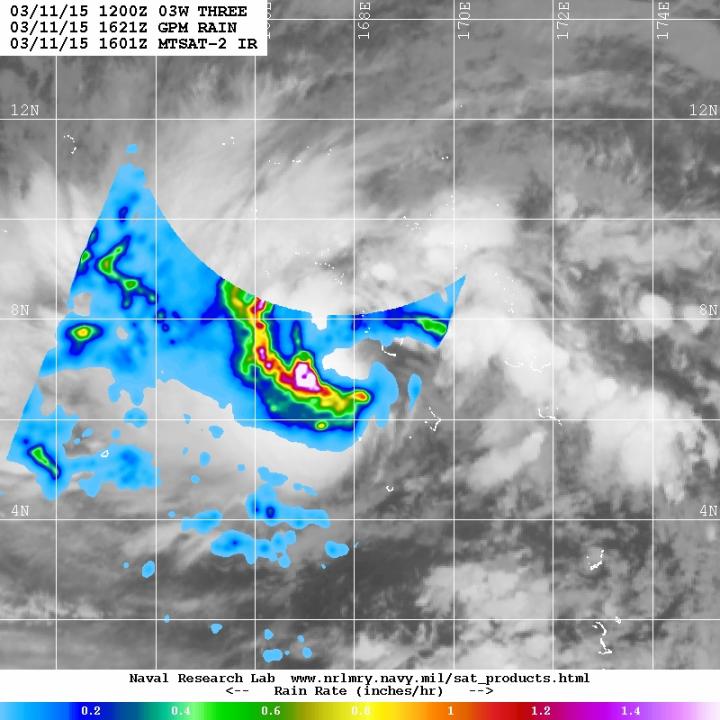NASA-JAXA's GPM sees birth of Tropical Depression 3W in northwestern Pacific

NASA-JAXA's GPM core satellite saw heaviest rainfall at a rate of 1.6 inches (40 mm) per hour was occurring southwest of TD03W's center on March 11, 12:21 p.m. EDT. Credit: NASA/JAXA/NRL
A tropical storm watch was already in effect on March 11 for Ujae and Ailinglaplap atolls in the western Marshall Islands.
The Global Precipitation Measurement or GPM core satellite gathered rainfall data on TD03W when it passed overhead on March 11 at 16:21 UTC (12:21 p.m. EDT).
GPM saw that the heaviest rainfall was occurring southwest of the center of circulation where rainfall rates were near 1.6 inches (40 mm) per hour.
On March 11 at 1500 UTC (11 a.m. EST), Tropical Depression 03W (TD03W) formed just 92 nautical miles south of Kwajalein, part of the Marshall Islands.
The center of TD03W was located near 7.2 north latitude and 168.2 east longitude. TD03W's maximum sustained winds were near 30 knots (34.5 mph/55.5 kph).
It was moving to the west at 18 knots (20 mph/33 kph) and is expected to become a tropical storm.
TD03W is forecast to move to the west-northwest toward Guam.
Media Contact
All latest news from the category: Earth Sciences
Earth Sciences (also referred to as Geosciences), which deals with basic issues surrounding our planet, plays a vital role in the area of energy and raw materials supply.
Earth Sciences comprises subjects such as geology, geography, geological informatics, paleontology, mineralogy, petrography, crystallography, geophysics, geodesy, glaciology, cartography, photogrammetry, meteorology and seismology, early-warning systems, earthquake research and polar research.
Newest articles

Properties of new materials for microchips
… can now be measured well. Reseachers of Delft University of Technology demonstrated measuring performance properties of ultrathin silicon membranes. Making ever smaller and more powerful chips requires new ultrathin…

Floating solar’s potential
… to support sustainable development by addressing climate, water, and energy goals holistically. A new study published this week in Nature Energy raises the potential for floating solar photovoltaics (FPV)…

Skyrmions move at record speeds
… a step towards the computing of the future. An international research team led by scientists from the CNRS1 has discovered that the magnetic nanobubbles2 known as skyrmions can be…




















